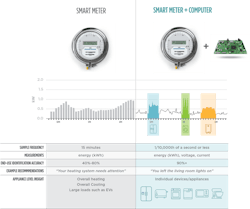Digital Platform Regulations for Electric Utilities: Part 1
New smart meter digital platforms provide fertile ground for energy innovation. But with an opportunity for electric utilities to hinder competition and impede their distributed energy competitors, regulatory oversight is needed. In Part 1 of this two-part series, the author analyzes the new competitive landscape of electricity-related services through the lens of digital platform regulation. Part 2 will discuss the lessons learned from the tech world and recommendations for electric utility regulators.
Electric utilities are increasingly providing digital services such as data portability to distributed energy resources (DERs), but government regulation of these monopolies has not adapted to the digital age. Unfortunately, rate regulation alone is ill-equipped to face modern challenges posed by the digitization of the power sector. DERs provided by non-incumbents have digital interactions with utilities, such as gathering real-time or historic electric usage data and billing information, and provide demand reduction services back to the utility.
New smart meters feature on-board computers that create tremendous opportunity for innovative DERs that would benefit customers. But they also create opportunities for utilities to abuse their market power by exploiting asymmetries of information and discriminating against DER providers by limiting access, withholding information, or imposing onerous terms of use.
Just as the U.S. Congress and countries around the world are grappling with how to regulate the tech giants' app stores, such as Apple's, state public utility regulators must familiarize themselves with abuses that are coming to the electricity sectorUtilities' digital platforms need oversight
The modern power grid is becoming increasingly decentralized, decarbonized, and digitized. Industry and state utility regulators are beginning to grapple with the first two trends — decentralization and decarbonization. But relatively little attention has been paid to the third trend: digitization. The objectives of this article are to (1) demonstrate the need for digital platform regulation, particularly as it relates to utilities' anti-competitive conduct that harms DERs, and to (2) propose policy solutions in the form of fair competition principles to guide regulators as the electricity system enters a new era.While we acknowledge that some utility-owned DERs are useful and necessary, in order to meet the need for rapid emissions reductions in the face of climate change, the digital playing field must be leveled between all DERs and utilities. Our assumption in this article is that behind-the-meter innovation will only occur at the speed necessary to address climate change if non-utility DERs (that is, DERs owned or controlled by customers and/or customer-selected third parties) are permitted to proliferate. And as non-utility DERs grow, certain digital interactions with the utility become necessary, as exhibited during the recent California heat wave when third-party demand response providers were called upon by utilities to manage peak demand and avoid blackouts. DERs often require electronic access to customer usage data and certain information about customer accounts held by the utility in order to operate. It is these digital interactions between co-equal market participants — utilities and third-party DERs — where regulatory oversight is necessary to ensure a level playing field.
State public utility commissions have no choice but to become digital platform regulators in order to be effective in the 21st century. Utilities have many IT systems whose interactions with DERs must be overseen. The first major digital platform to come about has been Green Button Connect (GBC). Used in five states today, covering 36 million electric meters, GBC electronically provides customer-authorized DERs with energy usage and billing information necessary for DERs to function. Unfortunately, these platforms have not always worked reliably (or sometimes haven't worked at all).
Recent technological developments besides GBC cry out for oversight of digital platforms. The latest is a new generation of smart meters that contain on-board computers. These computers allow software apps to be loaded on the meter. Apps could, for example, analyze electricity usage at high frequencies and disaggregate consumption by appliance or device. The ability to load an app onto a meter at zero marginal cost and receive accurate disaggregation of energy use is potentially game-changing for DERs, which could better understand each household and more accurately target their customers with cost-effective efficiency recommendations. For this new "app store" on advanced meters to benefit customers and to maximize its carbon-reducing potential, state regulators must force utilities to make these computing advancements accessible to third parties. Regulators must move beyond cost-of-service regulation by adopting pro-competition principles and developing enforcement mechanisms tailored to digital interactions.
How utilities can discriminate against DERs
App stores on smartphones have seen discrimination and anti-competitive activities in the past, as we discuss below. Utilities are poised to similarly hinder competition by virtue of their control over meter-based app stores. Examples of potential abuses include:
- Prohibiting apps from duplicating utility-provided functions: Suppose a software company makes an app that sends you text message alerts when you approach a budgeted amount for your monthly electric bill. This would be valuable to many customers, but many utilities already offer "high bill alerts" via text message. Utilities eager to maintain their direct customer relationship could ban similar apps in order to retain "ownership" of the customer. In the past, Apple has banned podcast apps that would have competed with Apple's native podcast app and music apps that would have duplicated some of iOS' built-in music functions.
- Privileging a utility's pre-installed apps with better user experiences: Your electric meter could come pre-installed with apps for energy disaggregation and bill alerts, courtesy of a utility. However, the utility could make it difficult or complex for customers to consent to the installation of a third-party app that provides similar capabilities. Pre-installed apps involve less "friction" of user experience because they can be used immediately without completing a consent process or waiting for the app to be loaded. This pitfall could be remedied by (1) banning pre-installation of apps by a utility and (2) requiring all apps, whether utility- or third party-made, to follow the same customer consent process.
- Utility-friendly app makers receive better treatment: App makers that are friendlier to a utility's business model could receive faster approvals, have terms and conditions selectively waived, or have reduced fees or commission percentages. A firm providing, say, behind-the meter battery storage that reduces a utility's capital investment (and thus earnings) would be a prime target for "back-burner" treatment, whereas an app beneficial to a utility could be welcomed with a red carpet. When Uber was in violation of Apple's terms, Apple's CEO telephoned Uber's CEO and amicably resolved the disagreement. Smaller firms than Uber, however, would have simply seen their app banned from the app store without an opportunity to appeal. Utilities must be agnostic when it comes to which services their customers choose. Size, political influence, or business model should not influence how an app maker is treated by a utility.
- Crippling hardware features to third-party apps such as voltage or current measurement: A utility could allow its own apps to access voltage or current information while providing inferior power data to third-party apps. Voltage and current measurement permits even greater accuracy with load disaggregation. Certain "signatures" seen in voltage and current fluctuations are traceable to certain loads, such as motors or compressors, in a way that power data (measured in watt-hours) cannot discern. Platform operators can reserve superior information for themselves via private APIs.
Existing regulatory approaches are inadequate
Today, the primary tool of utility regulation is disallowing costs from inclusion in rates. Utilities must prove to their regulator that they have "prudently" incurred costs, meaning that those costs were necessary to deliver safe and reliable electric service. One could argue that the threat of cost disallowance is sufficient to compel a utility to operate its IT platforms in such a way that is open to DERs, pro-competitive, and maximally beneficial to customers. But there are several reasons why the threat of cost disallowance is by itself inadequate to ensure positive outcomes for digital platforms that serve DERs and customers:
- Disallowance is costly for regulators to prove: Utilities can exploit information asymmetry to frustrate regulators' efforts to get information about the performance of IT platforms and app stores. And, because utilities' legal costs are paid by ratepayers, they can outmaneuver and outlast state regulators. Utilities can even appeal disallowances in court, further straining regulators' resources. As a result, disallowances are rare, diminishing their coercive force.
- Time lags between prudence reviews: Often, several years elapse from the time a utility's IT platform fails and the punishment (that is, cost disallowance) is meted out (if punishment occurs at all). In contrast, in a competitive market, the failure of an IT platform results in immediate financial consequences in the form of reduced users, lowered revenue, and contractual penalties. A delayed feedback loop in conventional prudence reviews is not only a departure from norms in a competitive market, but it is also ill-suited to IT systems that can change rapidly. For example, a perfectly functional IT platform can become inoperable within seconds.
Performance-based regulation (PBR) is one possible mechanism for correcting these shortfalls. However, for PBR to be successful, regulators must educate themselves about the desirable outcomes for utilities as digital platform operators as well as the undesirable outcomes to be avoided. We propose several performance metrics and tools for regulators that will be necessary to oversee digital platforms, whether or not PBR is applied. But first, we must understand the lessons learned regarding the market power wielded by digital platform operators in other industries, most importantly app stores on smartphones.
About the Author
Michael Murray
Michael Murray is co-founder and president of Mission:data Coalition, a non-profit coalition of 30 innovative energy technology companies that empower consumers with access to their own energy data. Previously, Murray served as co-founder and CEO of Lucid, an energy management software company for commercial buildings. He has more than 18 years of experience with building automation, energy management, metering, and public utility regulation. He earned his BA with highest honors from Oberlin College.


